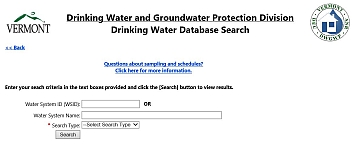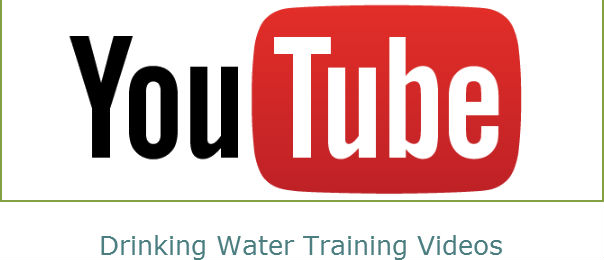The Revised Total Coliform Rule (RTCR) became effective on April 1, 2016, and replaced the previous Total Coliform Rule which had been in effect since 1989. The RTCR applies to every regulated public water system in Vermont. The RTCR utilizes total coliform bacteria monitoring as an indicator for water system integrity and to signal possible fecal contamination or the presence of waterborne pathogens.
Total coliform are a group of bacteria that does not necessarily pose an immediate risk to public health, absent of E. coli or other waterborne pathogens (things that can make you sick). Total coliforms exist in all sorts of locations, including plant and soil material and in digestive tracks of animals. It should not, however, be present in finished drinking water. The presence of total coliform in drinking water indicates a potential pathway by which something more harmful, such as E. coli or other waterborne pathogens, can enter the drinking water distribution system. Instead of sampling for a number of parasites, viruses, and other bacteria which can be difficult and expensive, total coliform are used as the indicator for how well a system is doing at keeping pathogens out of the drinking water. If total coliform are getting into the water, it means that a pathway exists through which more harmful pathogens can get into the drinking water.
RTCR Monitoring Requirements:
- Samples collected to perform routine monitoring for total coliform and E. coli bacteria are performed at a frequency of either each calendar quarter or month. The timeframe during which samples are required to be collected is the monitoring period.
- The number of samples collected during each monitoring period depends primarily on population served but can also depend on other factors.
- Your monitoring schedule can be found online at the following link:
https://anrweb.vt.gov/DEC/DWGWP/SearchWS.aspx - All samples must be analyzed by a laboratory certified to perform the desired analysis for Vermont public drinking water systems. A list of certified labs and the types of analysis they are approved for can be found at the following link:
https://www.healthvermont.gov/sites/default/files/documents/pdf/PHL_DW-Certified-Labs.pdf
Which sample type should I select on my laboratory paperwork?
There are four different sample types that you might use when submitting coliform samples. The laboratory paperwork, also known as the Chain of Custody, can differ depending on which certified lab you are using. The sample type you select is important and depends on the purpose of the sample.
- Routine (RT) – are the required “normal” samples collected during each monitoring period. These samples are used to determine compliance with the RTCR. Routine samples are collected from locations in the distribution (i.e. not the source location) as identified in the RTCR Coliform Sampling Plan (see below for Sample Plan guidance). Routine samples are typically collected either monthly or per calendar quarter.
- Repeat (RP) – are a group of three samples following every routine total coliform-positive sample. They include the same location as the routine positive sample; within 5 connections upstream of the routine positive sample location; and within five connections downstream of the routine positive sample location.
- Raw Water Source (TG) – this applies to groundwater sources only (i.e. not surface water or groundwater under the direct influence of surface water sources) and is a sample collected following a routine total coliform positive sample, along with the three repeats, and helps determine if the source itself is contaminated or if the water is getting contaminated somewhere else in the water system. The source sample is collected prior to any treatment and as close to the well as possible, but still from a faucet/sample tap of proper sanitary condition for the collection of total coliform samples.
- Special (SP) – these are samples that are not collected for compliance with the Revised Total Coliform Rule (RTCR). They are often used following construction or to lift a boil water notice in order to “check” the water quality without triggering additional monitoring under the RTCR. There may still be additional work to be completed based on the results of special samples, however, it would not be under the framework of the RTCR. There are many appropriate reasons to label a sample as special but a special sample will not be used to meet the routine, repeat, or raw water source monitoring requirements.
What to do when a routine sample is positive for total coliform or E. coli?
First, confirm on your laboratory report if only total coliform were detected or if E. coli were also detected in the sample. Whenever a sample is positive for the presence of total coliform, your certified lab must also report if E. coli are present in the sample. If E. coli are present in the sample, reach out to the Drinking water and Groundwater Protection Division (Division) RTCR contact immediately to discuss. Division contacts can be found at the Division's contact website. If you find out about the E. coli detection over a weekend, long holiday, or otherwise cannot submit repeat and source samples within 24 hours, a Boil Water Notice will need to be implemented. A Boil Water Notice template for this situation is available.
For EVERY routine total coliform positive sample perform the following within 24 hours of being notified of the sample results (If circumstances prevent collection within 24 hours, they should be collected as soon as possible but no later than the 8th day from the sample collection date). The repeat samples cannot be waived under any circumstances.
- All water systems must collect three repeat samples according to your RTCR Coliform Sample Plan, all on the same day.
- The same location as the routine positive sample;
- Within 5 connections upstream of the routine positive sample location; and
- Within 5 connections downstream of the routine positive sample location
- Groundwater sources only: Per the Groundwater Rule, collect one sample from each active groundwater source at the location(s) identified in your RTCR Coliform Sampling Plan. If E. coli are detected in the groundwater source sample, reach out to the Division contact to discuss the next steps which will include but not necessarily limited to collection of an additional five source samples.
IMPORTANT If E. coli are detected in your routine sample and you cannot deliver the source and repeat samples to the lab within 24 hours of being notified of the sample results, you must distribute a Boil Water Notice (BWN) in accordance with the Boil Water Procedure pending results of the source and repeat samples.
The Boil Water Procedure and copy of the E. coli-related Boil Water Notice template can be found on our website.
- If your monitoring frequency is per calendar quarter, you will also need to collect three routine samples the month following the routine positive sample. This is in addition to the source and repeat monitoring identified above.
- If any repeat sample is positive for total coliform, reach out to the Division contact to discuss the next steps which will include but not necessarily limited to an RTCR Assessment.
- If a repeat sample is positive for E. coli, a BWN must be posted immediately in accordance with the Boil Water Procedure (see box above for links) and reach out to the Division contact to discuss the next steps which will include but not necessarily limited to an RTCR Level II Assessment.
Monitoring Schedule Change from Quarterly to Monthly
Only year-round, non-community water systems that serve a population of 1,000 or fewer people with only groundwater can be eligible to monitor on a quarterly basis. Other conditions may apply. The monitoring frequency will be changed from quarterly to monthly if any one of the five situations below occur:
- The Water System triggers a Level 2 Assessment or two Level 1 Assessments in a rolling 12-month period; or
- The Water System has an E. coli Maximum Contaminant Level violation; or
- The Water System has a coliform treatment technique violation; or
- The Water System has two RTCR monitoring violations in a rolling 12-month period; or
- The Water System has one RTCR monitoring violation AND triggers a Level 1 Assessment in a rolling 12-month period.
If your water system experienced one of the conditions above and was changed from quarterly to monthly, the frequency can be returned to quarterly. To do so, you must request and be formally authorized to return to quarterly monitoring. Your schedule will not automatically return to quarterly monitoring. If you have not been formally authorized to return to quarterly sampling and a monthly sample was not collected, a monitoring violation will be issued and there will no longer be a clean compliance history. The following conditions must have been met during the previous twelve months prior to requesting to return to quarterly monitoring:
- The issue that led to the increased monitoring has been resolved;
- Be free of sanitary defects. This includes any sanitary defect that may have been identified prior to beginning increased monitoring;
- Have a clean compliance history. This includes not triggering a RTCR Level I or Level II Assessment and having no RTCR-related violations for the previous twelve months;
- Have a protected source. This includes but may not be limited to having a valid Source Permit, a groundwater under the direct influence of surface water (GWUDI) determination, no source-related deficiencies or defects, and/or a current approved Source Protection Plan (if applicable); and
- Have had a Sanitary Survey or voluntary Level II Assessment by a State-approved contractor (note that a triggered Level II Assessment does not meet this requirement). This should be the final step, after all the other requirements have been met, in order to confirm there are no further sanitary defects at the time you are petitioning to return to quarterly sampling.
| Firm | Contact | Location | Phone | Website | |
|---|---|---|---|---|---|
| Earth Water Specialist, Inc. | Paula Jackson | Colchester | Office: (802) 878-7636 Mobile: (802) 343-1356 |
paulajacksonews@ gmail.com |
|
| DuBois & King | Andrew Hoak, PE and Jon Ashley, PE | Jon: Brandon Andrew: Randolph | Jon: 802-465-8376 Andrew: 802-728-3376 |
Jon: jashley@ dubois-king.com Andrew: ahoak@ |
https://www.dubois- king.com |
| Aquaterra | Roland Luxenberg | North Ferrisburgh | 802-238-0071 | roland@ luxenberg.us |
N/A |
| Marble Valley Engineering, PC | Kevin Smith, Project Manager | Rutland | 802-775-1181 X14 | http://www.marblevalley engineering.com |
Site Assessment Resources
A level 1 site assessment is triggered when a system has two or more total coliform positive samples in one month or if the system fails to take all required repeat samples following a positive routine sample.
If the system triggers a second Level 1 Site Assessment within 12 months or exceeds the E. coli MCL, a Level 2 Site Assessment will need to be performed. Below you will find some guidance on site assessments:
Having issues identifying sanitary defects or corrective actions? This is a guidance on sanitary defects and acceptable corrective actions.
RTCR Sampling Plan Forms
- RTCR Sampling Plan Form for Systems Serving 1,000 people and under
- RTCR Sampling Plan Form for Systems Serving 1,001 and over


